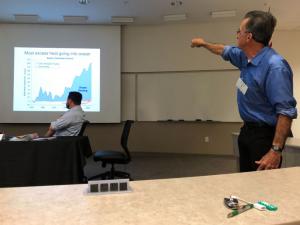David Hastings Discusses How The Pandemic is Affecting Climate Change
David Hastings On How The Pandemic is Affecting Climate Change
GAINESVILLE, FL, UNITED STATES, September 23, 2020 /EINPresswire.com/ -- “This is a subject that will continue to evolve as new studies are performed and new information comes out,” says Dr. David Hastings, former professor of marine science and chemistry, and current environmental activist. “But overall, the findings have been very interesting to watch.”Certain Waterways are (Temporarily) More Clear Says David Hastings
The pictures of exceptionally clear canals in Venice during the pandemic are stunning. Without tourists using boats to explore the city, the canals cleared in a matter of weeks. Sediments, normally stirred up by the boats, settled back to the bottom of the canal and water clarity has increased dramatically. Cormorants could dive for fish, and the visual clarity meant that other life started moving into the clear water.
It was a moving example of how nature can recover when humans take a step back. But it is also a temporary condition. Tourists will return, taking their boat rides, and the water will again become turbid. The best way to conserve and protect natural systems and our environment is to bring about large-scale policy change, according to David Hastings.
“In general, many environmental systems are resilient. Given enough time, these systems can recover from harmful impacts. But only if we stop overwhelming them with the environmental insults including pollution, runoff, chemical contamination, and the impacts of climate change. Our ecosystems are remarkably resilient. However, past a certain threshold the ecosystem undergoes a regime shift, which can be permanent. These thresholds are not well understood.”
CO2 Levels Have Decreased Says David Hastings - But They’re Still Rising
While greenhouse gas emissions decreased 10-30% as a result of the pandemic, globally they will still be higher than last year. The Carbon Brief estimates that CO2 levels in the atmosphere will increase by 2.48 parts per million in 2020. This is 0.32 parts per million smaller than the expected rise - or eleven percent of the expected rise.
These numbers are evidence that it is possible to decrease the level of our individual CO2 emissions by decreasing our travel by car and plane, which are important parts of total carbon emissions. But personal transportation is not the only or most important contributor to CO2 and other greenhouse gases to the atmosphere. We have to make systemic changes that include energy sources, cement production, deforestation and farming practices to see long term results.
Single-Use Plastic Use is Rising During the Pandemic Says David Hastings
Unfortunately, the improvements we are seeing for the environment - reduced air pollution, reduced waste from restaurants and retail markets, etc. - are being outweighed by a rise in single-use plastic. The take out packaging, discarded masks and other PPE, the wrap on your jumbo pack of toilet paper ,and the plastic packaging in your online orders - it all ends up in a landfill. And some of that will eventually end up in the ocean.
Even recyclables like cardboard, cans, and glass bottles are ending up in the landfill more and more often as recycling plants are becoming overwhelmed with the influx of materials to be recycled. . David Hastings says while we are out in the world less, we are consuming more than ever. The packaging from online shopping is currently a significant source of single-use plastic in the US.
But how can we fight it? Stay safe, we need to order any essential products online. “Try to use brands that offer eco-conscious packaging solutions,” advises David Hastings. “I realize it’s not always a cost-effective option. And there are no good alternatives currently available for some products. In those cases, reach out to your favorite brands and encourage your friends to do the same.Let companies know that you, the consumer, want better options and that you’re willing to reward them with loyalty.
But eventually, for long term solutions to the problem of plastic pollution, we need to shift away from an environmental problem to an opportunity for economic development and building new businesses.”
Policy doesn’t change unless the people advocate for it, David Hastings reminds us. Tell your elected officials, your politicians, and your community leaders that you want to see change. And in the meantime, do what you can to reduce your own environmental footprint.
Caroline Hunter
Web Presence, LLC
+17862338220
email us here
Legal Disclaimer:
EIN Presswire provides this news content "as is" without warranty of any kind. We do not accept any responsibility or liability for the accuracy, content, images, videos, licenses, completeness, legality, or reliability of the information contained in this article. If you have any complaints or copyright issues related to this article, kindly contact the author above.

